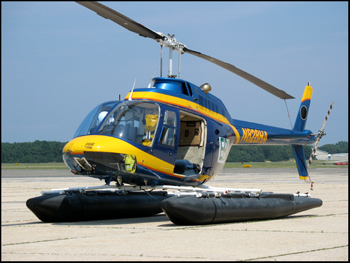EPA’s “Coastal Crusader” Keeps
Beach Season Cleaner
By Helen Grebe
As a college student without a car studying general biology in the late 1980’s, I needed a job in my major. As luck would have it, the EPA Edison, NJ office was within walking distance to my home and was offering a summer internship for the Helicopter Monitoring Program. Working with the Edison field and laboratory staff inspired me to dedicate my career to the environmental cause.

The "Coastal Crusader" surveys the waters of the New York/New Jersey Harbor, looking for "slicks" of floating debris that could wash up on area beaches.
EPA’s helicopter, fondly called the “Coastal Crusader,” has been flying over the New York/New Jersey Harbor Complex since 1989 and along the Long Island and New Jersey coastlines for many years before that. Currently, the program helps support NY and NJ shellfish programs and focuses on searching for floatable debris in the waterways.
Floatable debris can originate from street litter, combined sewer overflow (CSO) discharges, storm water discharges, decaying shoreline structures, pleasure boaters, and littering beach goers. Floatable debris can consist of a wide assortment of plastic, wood, paper, glass and rubber. Such things as plastic bags, plastic drinking bottles, mylar balloons, styrofoam cups, tires, straws and decaying piers are typically observed. This debris suspended in the water column may eventually be deposited on shorelines and local beaches causing harm to the marine environment and closures to local beaches.
The EPA helicopter crew, mostly made up of summer interns, coordinates cleanup of floatable debris six days a week by reporting debris to the Army Corps of Engineer’s skimmer vessels. These vessels are specially modified to pick up debris before it escapes the harbor.
Other programs such as the New Jersey Department of Environmental Protection’s Clean Shores program also help remove debris from the area. In fact, to date, approximately 408 million pounds of debris have been removed from the New York Bight area.
As extensive as these programs are, we can all do our part to protect local beaches and the marine environment by leaving no trash behind. How do you help keep your local beach clean?
Editor's Note: The opinions expressed in Greenversations are those of the author. They do not reflect EPA policy, endorsement, or action, and EPA does not verify the accuracy or science of the contents of the blog.
